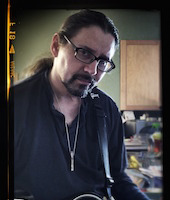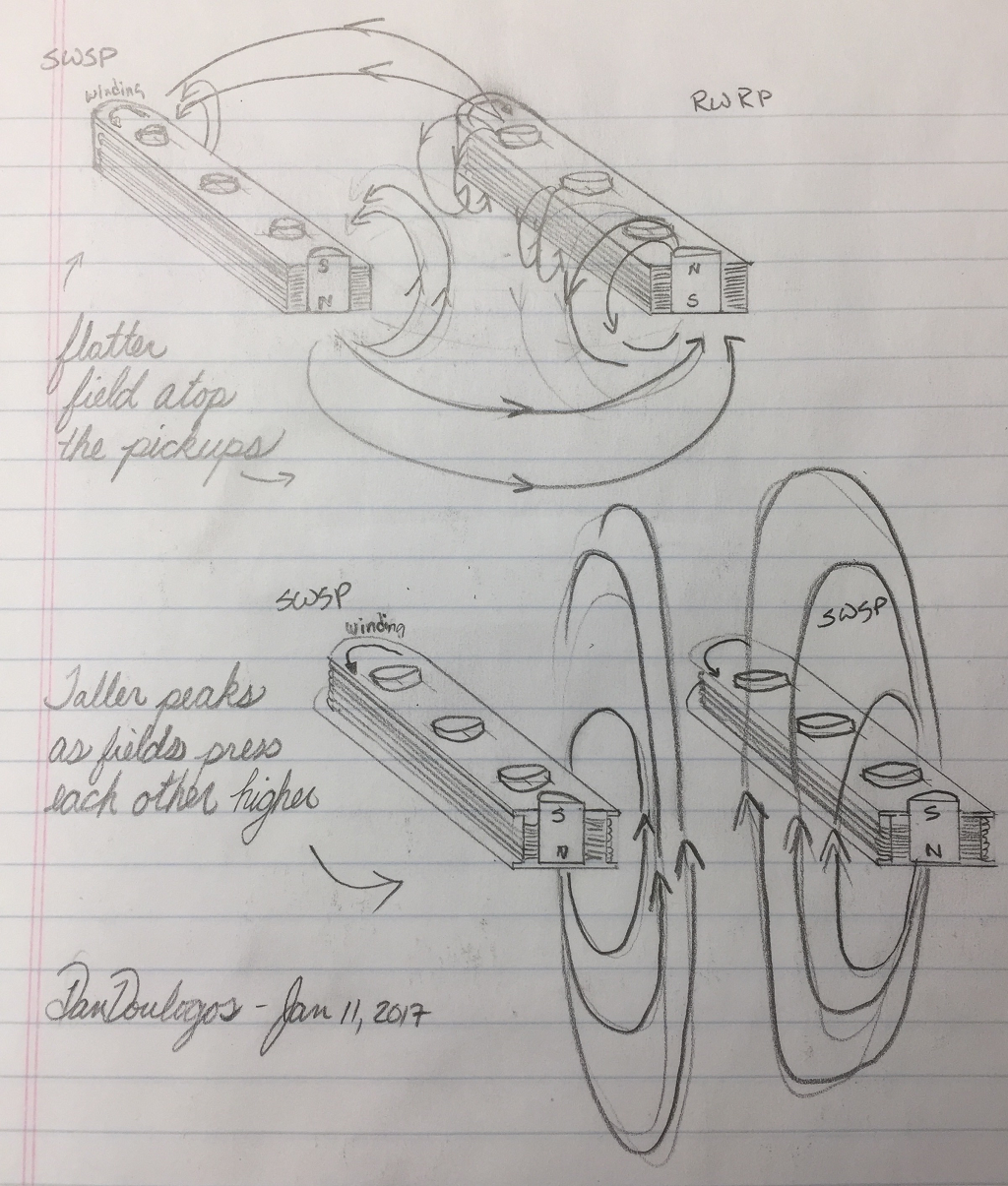Quack, as you probably know, is the (for better or worse) label that is being used to describe that phase-y sound when your playing through two single coil pickups at the same time. (think position 2 and 4 on an SSS Legacy or Strat). There are a lot of opinions about quack, and some interesting discussion about how to diminish or (and this is by far the lion's share of the discussion) increase this quality.
Obviously there are some pretty standard things you can do to increase or decrease the quack factor on your guitar. The easiest adjustment is to lower the height of your middle pickup - which (counter-intuitively) increases the quack.
There is a lot of mystery on the Internet about where quack comes from - so after some study, I think I understand the basics, and thought this would be a helpful thing to share with others, so here goes.
Have you ever been weed-whacking with an electric weed-whacker, and got the cord stuck on something several feet away? You know what you do, right? You whip the cord with a twist, and watch as a sort of spiral moves along the cord to the snag. If all goes well, as the spiral passes over the snag, it un-snags - and you're good to go.
This is a picture of a wave moving along a string. When you pluck a note on a guitar string, you're sending a hump down that string. It moves away from the place you plucked the string, and like water sloshing back and forth in the confines of a tub - the wave in the string sloshes back and forth between the nut and bridge.
What we see as a guitar string vibrating is really the same wave rebounding between two fixed points. It really is moving from nut to bridge or fret to bridge (if fretted). We don't see that, but that is what is happening.
The wave that is moving is an aggregate of all its harmonics. We prove this to ourselves by plucking the note, then lightly tapping the string at the 12th fret - this mutes the largest (in wavelength, but lowest in frequency) harmonic (i.e. the "fundamental" harmonic) making the "second" harmonic now the dominant harmonic in the string. Plucking harmonics is just a way of muting out the larger wavelengths in the string.
What we want to understand here is that these harmonics are also moving back and forth along the string - they are there, even if we don't see them because they are "buried" in the dominant harmonic being heard. But they are certainly moving up and down the string - and the higher the harmonic - the smaller the wave length.
Why does that matter? It matters because these waves run along the string in the form of a sin wave. what we see as a cigar shaped vibration is actual an aggregate of all the harmonics present in the string moving up and down the length of the string. At any given moment the same harmonic over pickup A may be cresting, while over pickup B it is in decline. When these two pickups are combined in parallel - that means some harmonics will be amplified, and others will be diminished.
This is a function of the distance between the pickups and the frequency of the notes.
That is why lowing the middle pickup increases the quack - because in lowering the pickup (relative to the other), you are more likely to pick up only the bottom half of each harmonic wave - causing a more noticeable effect since only half the effect is happening - it effectively cuts the "speed" of the effect in half - making it more "noticeable".
So that describes where the quack comes from - it is kind of a natural "comb-filter". Certain changes (magnets, pickup position/orientation, etc.) will increase the characteristic to a greater or lesser degree - but it is essentially a natural harmonic by-product of putting two single coil pickups in parallel as they express the differences in tonal qualities (harmonic amplitudes) as they momentarily pass over the pickups.
That's what I've come to conclude at least. In some of the places I've looked for answers the answer is often more mystical or brand-name dependent - but it seems to me it's just physics.
I looked into this because I wanted to know if standard Strat wiring was more "quacky" than the PTB wiring set up. Seems to me that this effect has nothing to do with wiring schemes, but rather that different wiring schemes would be less effective than others in highlighting this effect (I think the PTB wiring should allow you to "tune" the effect with more "headroom" than a strat wiring set up.
Anyone have any personal experience comparing PTB quack and the original Fender wiring quack? I'd be keen to hear any comments, opinions, or thoughtful corrections.
Concerning "Quack"... (long, but hopefully thoughtful post)
-
DanDoulogos

- Posts: 713
- Joined: Tue Dec 20, 2016 9:08 am
- Location: Canada
Concerning "Quack"... (long, but hopefully thoughtful post)
G & L: '08 Comanche (Tribute) | '14 ASAT Classic | '00 ASAT Spec | '21 JB2 (Tribute)
Other: '87 Strat | '05 Heritage CH-157 | '12 Tele Select Koa | '19 MJT Esquire | '18 Taylor | 2015 Chrome Epi Dobro |
Other: '87 Strat | '05 Heritage CH-157 | '12 Tele Select Koa | '19 MJT Esquire | '18 Taylor | 2015 Chrome Epi Dobro |
-
themikeaustin
- Posts: 92
- Joined: Sat Sep 12, 2015 10:36 pm
Re: Concerning "Quack"... (long, but hopefully thoughtful po
I think part of the conventional wisdom has been that a) the middle pickup emphasizes slightly different harmonics than the bridge or neck pickup and b) the reverse coil of the middle pickup makes the overall signal slightly out of phase.
I recently sold my Strat, but I think it definitely was more "quacky" than the S-500 I replaced it with. When I got the S-500 I immediately lowered the pickups (as I did for all my MFD pickup guitars) as I find it reduces the harshness and increases the sustain. I can get a good approximation of the Strat's quack by putting the bass control ~ 3 and the treble control ~ 6.
However, I have two ASAT Specials and the neck pickups are reverse-wound relative to the bridge pickups, and there's no quack when both pickups are played, which would seem to invalidate the first paragraph above.
I recently sold my Strat, but I think it definitely was more "quacky" than the S-500 I replaced it with. When I got the S-500 I immediately lowered the pickups (as I did for all my MFD pickup guitars) as I find it reduces the harshness and increases the sustain. I can get a good approximation of the Strat's quack by putting the bass control ~ 3 and the treble control ~ 6.
However, I have two ASAT Specials and the neck pickups are reverse-wound relative to the bridge pickups, and there's no quack when both pickups are played, which would seem to invalidate the first paragraph above.
-
DanDoulogos

- Posts: 713
- Joined: Tue Dec 20, 2016 9:08 am
- Location: Canada
Re: Concerning "Quack"... (long, but hopefully thoughtful po
From what I've read elsewhere, neither the RWRP nor the PTB wiring removes the comb-filtering effect we call "quack", but I suspect combining an RWRP with a standard pickup would affect it - since you're changing the (aggregate) direction of the magnetic field above each pickup (see below).themikeaustin wrote:... I have two ASAT Specials and the neck pickups are reverse-wound relative to the bridge pickups, and there's no quack when both pickups are played, which would seem to invalidate the first paragraph above.

When we pluck a string we cause a wave to run back and forth over the string - bouncing back upon itself at the nut and bridge. Though the motion of the wave moves down the string - the string itself moves from side to side as the wave passes by. It is this motion that pulls the magnetic field around and induces a current in the coil. This motion runs perpendicular to the string (the string is tied left to right, but vibrates up and down). Where the magnetic field is flatter atop the pickup (lining up with the string directions), the vibration of the strings will be perpendicular to the field - and induce a larger signal in the coil.
It follows that a Standard+RWRP coupling ought to cancel out whatever noise is not coming from the pickups, and put more signal in the coils because the string's vibration cuts more perpendicularly where the field direction is flatter. One would expect that to translate into a sharper comb-filtering effect (i.e. one would expect the harmonic amplification/cancellation effect to be less buried by ambient noise).
I'm not really sure what to make of your ASATs/RWRP combo. There should still be some comb-filtering going on, since there will be a difference in amplitude in the string over each pickup.
I plan to drop a RWRP SSL-2 in the middle position of my legacy when the copper shielding I ordered arrives. I sure hope it doesn't (overly) mute the quack...
(edit: spellchecking)
G & L: '08 Comanche (Tribute) | '14 ASAT Classic | '00 ASAT Spec | '21 JB2 (Tribute)
Other: '87 Strat | '05 Heritage CH-157 | '12 Tele Select Koa | '19 MJT Esquire | '18 Taylor | 2015 Chrome Epi Dobro |
Other: '87 Strat | '05 Heritage CH-157 | '12 Tele Select Koa | '19 MJT Esquire | '18 Taylor | 2015 Chrome Epi Dobro |